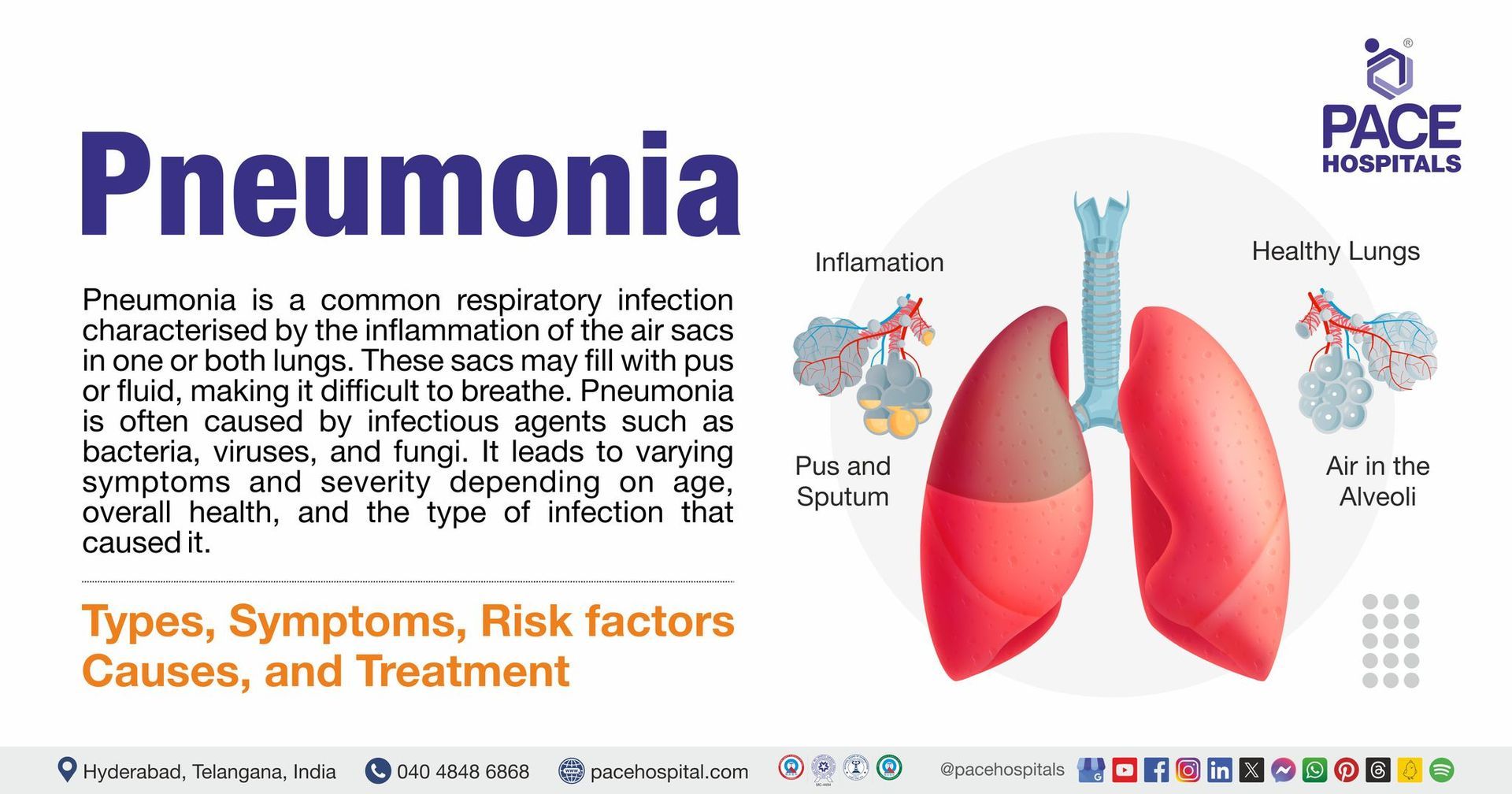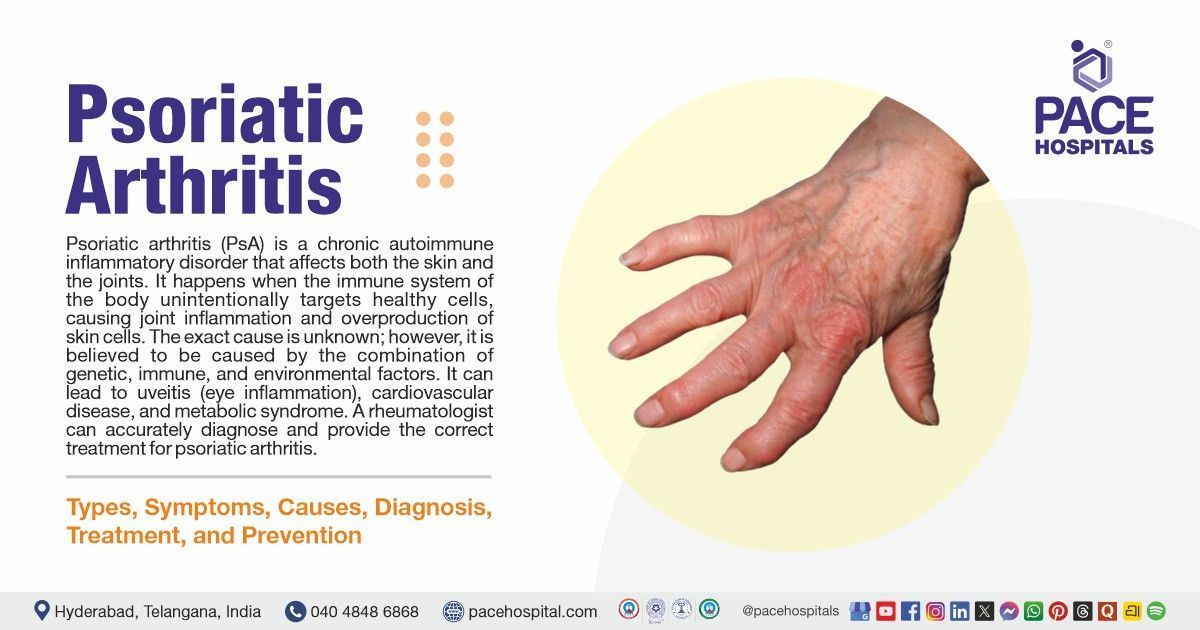Pneumonia - Symptoms, Causes, Risk factors, Treatment, Prevention
Pneumonia definition
Pneumonia is a common respiratory infection characterised by the inflammation of the air sacs in one or both lungs. These sacs may fill with pus or fluid, making it difficult to breathe. Pneumonia is often caused by infectious agents such as bacteria, viruses, and fungi. It leads to varying symptoms and severity depending on age, overall health, and the type of infection that caused it.
Pneumonia meaning
The term "pneumonia" derives from the ancient Greek language word "pneumon," meaning "lung," thus translating to "lung disease."
Pneumonia Prevalence Worldwide
Pneumonia is a type of acute lower respiratory tract infection, which is one of the leading causes of death, affecting approximately 450 million people a year and occurring in every part of the world, particularly in young children and elderly adults.
As per the World Health Organization (WHO), pneumonia accounts for nearly 15% of all deaths among children under 5 years old, making it a significant health concern.
The newborn lung is more vulnerable to bacterial and viral infections, and neonatal pneumonia is a significant cause of morbidity and mortality worldwide. Between 152,000 - 490,000 infants aged < 1 year die of pneumonia annually.
Incidence of pneumonia worldwide
The worldwide incidence of community-acquired pneumonia (CAP) is between 1.5 and 14 cases per 1,000 people per year.
The incidence of hospitalised pneumonia in adults increased from 13.49 per 10,000 people in 2015 to 17.65 per 10,000 people in 2018.
The risk of CAP is higher in males than females and increases with age. It is more commonly seen in winter months.
Many of the above-mentioned cases are preventable with proper vaccinations and treatment.
Prevalence of Pneumonia in India
The prevalence of pneumonia in India is alarming, with thousands of cases annually, accounting for a high number of hospitalisations, morbidity and mortality, particularly among children and the elderly, remaining a significant cause of death, especially in rural regions with limited healthcare access.
Incidence of pneumonia in India
The annual incidence rate of CAP (community-acquired pneumonia) in India is between 5 and 11 per 1,000 people.
Uttar Pradesh, Bihar, Madhya Pradesh, and Rajasthan are the top contributors to India's pneumococcal pneumonia burden.
Predisposing factors for CAP include increasing age, alcoholism, renal disease, chronic obstructive pulmonary disease (COPD), immunosuppression and chronic heart disease.
Types of Pneumonia
Several types of pneumonia in adults are categorised based on their cause, location, or the circumstances in which they were acquired. Below are some common types of pneumonia classified based on infection:
- Bacterial Pneumonia: HAP, CAP (Typical), VAP, Aspiration Pneumonia
- Viral Pneumonia: CAP (Atypical), Viral Pneumonia (e.g., influenza, RSV, coronaviruses)
- Fungal Pneumonia: Fungal Pneumonia
These classifications are determined by looking at the lung tissue under a microscope (histologically), including:
- Lobar Pneumonia: This form of pneumonia affects a significant portion of the lung, including the entire lung lobe.
- Bronchopneumonia: This type begins in the small airways (bronchi) and can spread to surrounding lung tissue. It is often patchy and affects multiple areas of the lung.
- Interstitial Pneumonia: It is characterized by inflammation in the interstitial walls rather than the alveolar spaces. Although viral pneumonia typically begins as interstitial pneumonia, severe cases often show an extension of the inflammatory process into the alveolar spaces as well.
Below are some common types of pneumonia classified based on duration and onset of symptoms of the infection:
- Acute Pneumonia: It develops rapidly and often causes severe symptoms, including high fever and difficulty breathing. It is most commonly caused by bacterial infections but can also be viral or fungal.
- Chronic Pneumonia: It refers to long-lasting or recurring infections. It can be caused by tuberculosis, fungi, or bacteria and typically affects individuals with weakened immune systems or underlying lung diseases.
The types of pneumonia in children and infants are the same as those in adults and can be caused by similar pathogens. However, the presentation can vary depending on the child's age, immune status, and the causative microorganism.
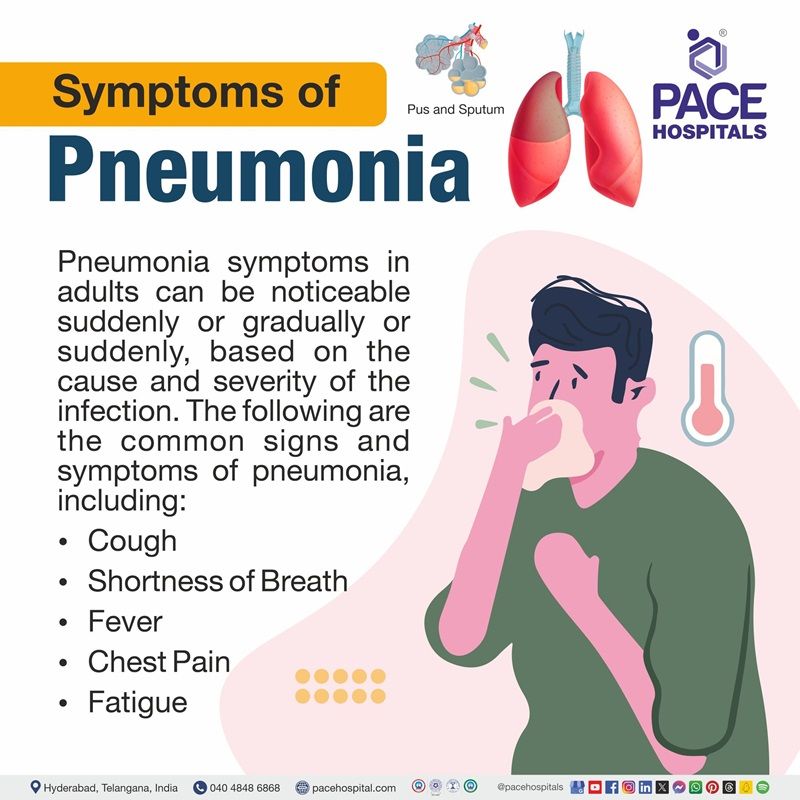
Pneumonia Symptoms
Pneumonia symptoms in adults can be noticeable suddenly or gradually or suddenly, based on the cause and severity of the infection. The duration of these symptoms may vary, usually lasting a few days to a couple of weeks. The following are the common signs and symptoms of pneumonia, including:
- Cough: A persistent cough with yellow, green phlegm or bloody mucus is one of the early symptoms of pneumonia, which may worsen over time as the infection progresses, especially with bacterial pneumonia.
- Shortness of Breath: SOB, or difficulty breathing, occurs when fluid and inflammation accumulate in the lungs' alveoli, making it harder for the body to absorb air efficiently.
- Fever (Pneumonia fever): It is a common symptom of pneumonia, often accompanied by chills and sweating, as the body's immune system reacts to the infection.
- Chest Pain: It often begins as a sharp or stabbing pain in the chest region, common in pneumonia, worsening with coughing or deep breaths, which indicates irritation or inflammation of the lining around the lungs.
- Fatigue: Fatigue and weakness are often experienced as the body expends energy fighting the infection. It can lead to general tiredness and a lack of energy.
Symptoms of pneumonia in babies
Symptoms of pneumonia in infants and children can be similar to those in adults (including cough, fever, or SOB); however, infants may also show additional signs like poor feeding, irritability, and nasal flaring.
Unlike adults, infants may not always be able to express discomfort clearly, so their symptoms may be more subtle or harder to recognise.
Symptoms of pneumonia in pregnancy
Signs and symptoms of bacterial pneumonia during pregnancy are similar to those in nonpregnant people. Symptoms include cough (over 90%), sputum production (66%), dyspnoea (shortness of breath - 66%), and pleuritic chest pain (50%). Signs include fever, crackles, and abnormal breath sounds.
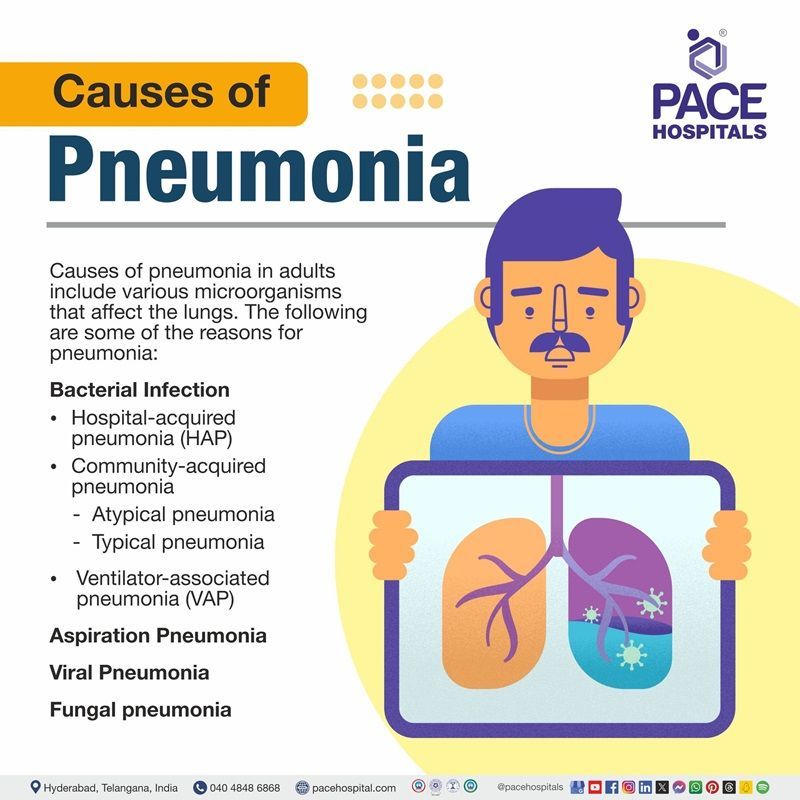
Pneumonia Causes
Causes of pneumonia in adults include various microorganisms that affect the lungs. The following are some of the reasons for pneumonia:
- Bacterial Infection: Bacterial infection is the most common cause of pneumonia, with Streptococcus pneumoniae being the most common pathogen. It can cause severe symptoms and may require antibiotics for treatment.
- Hospital-acquired pneumonia (HAP): Also called Nosocomial pneumonia, which is defined as an acute infection of lung tissue in a non-intubated patient that happens 48 hours or more after hospital admission. It is often associated with multidrug-resistant organisms, including methicillin-resistant Staphylococcus aureus (MRSA) and Pseudomonas aeruginosa, which are common causes of hospital-acquired pneumonia and typically occur in patients with certain underlying medical conditions or those undergoing invasive procedures.
- Community-acquired pneumonia (CAP): It is an acute infection of lung tissue that occurs in a patient who has acquired the infection outside of a healthcare setting or within the first 48 hours of hospital admission. It is primarily caused by pathogens such as Streptococcus pneumoniae and Haemophilus influenzae and atypical bacteria such as Mycoplasma pneumoniae, viruses, or fungi and affects otherwise healthy individuals. CAP is further divided into "atypical" and "typical."
- Atypical pneumonia: It is also called Walking pneumonia (due to its milder symptoms and slower onset), which is often characterised by an acute lung infection caused by pathogens that are not detectable by traditional Gram stain or standard bacterial cultures. Common atypical pneumonia causes or causative agents of this condition include Mycoplasma pneumoniae, Legionella pneumophila and Chlamydophila pneumoniae. These infections often present with less severe respiratory symptoms and more systemic manifestations than typical bacterial pneumonia.
- Typical pneumonia: This is a form of pneumonia commonly caused by bacteria like Streptococcus pneumoniae and other organisms, including Staphylococcus aureus, Klebsiella pneumoniae, Moraxella catarrhalis, Group A Streptococcus, Haemophilus influenzae, anaerobes, and gram-negative organisms. It usually presents with a sudden onset of symptoms, such as fever, cough, chest pain, and difficulty breathing. It typically affects a large portion of the lung and is more likely to cause a classic pattern of infection.
- Ventilator-associated pneumonia (VAP): It is a specific type of nosocomial infection that develops in patients who have been mechanically ventilated for 48 hours or longer (a common complication in intensive care units) and is often caused by multidrug-resistant pathogens. It typically develops because of the entrance of pathogens into the lower respiratory tract via the endotracheal tube, with common causative agents. The causes of ventilator-associated pneumonia include Pseudomonas aeruginosa, Klebsiella pneumoniae and Acinetobacter species. This type of pneumonia is associated with high mortality, morbidity, and prolonged hospital stays.
- Aspiration Pneumonia: It is a pulmonary infection resulting from the inhalation of bacterial-rich fluids, including oropharyngeal secretions, particulate matter, or gastric content (food, liquid, or vomit), into the lower respiratory tract. It causes severe symptoms and is common in individuals with swallowing difficulties or impaired consciousness (those under the effects of anaesthesia or alcohol).
- Viral pneumonia: Common viral pneumonia causes include influenza, respiratory syncytial virus (RSV), and coronaviruses. It typically presents with milder symptoms than bacterial pneumonia but can be severe in some cases.
- Fungal pneumonia: It is a non-contagious infection caused by fungal spores which is positively common, especially in highly immunosuppressed patients (solid organ or hematopoietic stem cell transplant recipients) or in people with chronic health problems and in people who are exposed to significant doses of certain fungi from contaminated soil or bird droppings.
- Recurrent pneumonia: It is defined as having at least two episodes in one year or three or more at any time frame with radiographic clearance between episodes. Recurrent pneumonia causes include immune disorders, asthma, aspiration syndrome, pulmonary anomalies and congenital heart disease.
- Other causes: It is also uncommon for pneumonia to be caused by non-infectious things, such as allergic reactions, blood circulation issues in the lungs, radiation, and inhaled poisonous substances.
Causes of pneumonia in infants
Neonatal Pneumonia: It is a form of lung infection in a newborn that can be caused by bacteria, viruses, fungi, or parasites. Newborns, especially preterm babies or those with compromised immune systems, are more vulnerable to infections. It can occur anytime, from within hours of birth to after seven days of age. Danger signs of pneumonia in infants include rapid or difficult breathing, bluish or grey lips or nails, chest indrawing, grunting, lethargy, unconsciousness, hypothermia or convulsions and difficulty feeding (inability to feed or drink).
Causes of pneumonia in pregnancy
Community-acquired pneumonia (CAP) is the common type of pneumonia during pregnancy, with the most identified bacterial organisms including streptococcus pneumoniae, Mycoplasma pneumoniae and Haemophilus influenzae. Pregnant women with coexisting maternal diseases such as anaemia and asthma can have an increase the risk of contracting pneumonia in pregnancy. Increased risk of preterm birth, low birth weight and serious maternal complications, including respiratory failure, are some neonatal effects of pneumonia in pregnancy.

Pneumonia Risk Factors
Certain risk factors can make people more susceptible to developing pneumonia. The following are some of the risk factors that contribute to the development of pneumonia, including:
- Age: The incidence of pneumonia increases with age and is highest in adults over 75 years old. Adults older than 65 years and children under 5 years old are at increased risk due to weaker immune systems. Elderly individuals may have chronic health conditions that make them more vulnerable to infections.
- Smoking: It damages the airways and weakens the lungs’ ability to clear out infections. Smokers are at more risk of developing pneumonia and experiencing more severe cases.
- Chronic Diseases: Having chronic conditions such as heart disease, asthma, diabetes, chronic obstructive pulmonary disease (COPD) or other conditions can increase the risk of pneumonia, as the immune system is often compromised.
- Weakened Immune System: People with an immunocompromised immune system or any disease or condition that impairs the person's immune response, such as, older age (older than 65 years), HIV/AIDS, cancer treatments, immunosuppressive medications, diabetes, cystic fibrosis, lung cancer, among others are at a higher risk for pneumonia-like infections.
- Hospitalisation: Hospital-acquired pneumonia is a risk for patients who are already sick, especially those on ventilators or undergoing surgery, as they may be exposed to antibiotic-resistant bacteria.
Malnutrition, alcoholism, and obstruction of bronchi from tumors are other common causes and risk factors of pneumonia.
Complications of Pneumonia
Pneumonia complications in adults can arise if the infection is severe, untreated, or not adequately managed, potentially leading to serious, life-threatening conditions. The following are some of the complications that may arise in pneumonia patients.
- Sepsis: It is a life-threatening complication of pneumonia that requires immediate medical attention, Sepsis is a widespread infection that can spread throughout the body, resulting in organ failure.
- Pleural Effusion: It's a potentially dangerous condition that can occur when pneumonia causes fluid to build up in the pleural space (the layers of tissue lining the lungs and chest cavity), causing difficulty breathing. If this happens, surgical drainage will be required.
- Lung abscess: Usually, it is a complication of pneumonia resulting from bacterial infection with aggressive organisms such as S. aureus or gram-negative enteric organisms. It can lead to severe chest pain, fever, and respiratory distress and may require surgery or drainage. Inhalation of foreign material also increases the risk lung abscess formation.
- Acute Respiratory Distress Syndrome (ARDS): It is a life-threatening lung injury that impairs oxygen exchange, ARDS occurs when the lungs are severely damaged, usually by trauma or infection, including pneumonia, sepsis, COVID-19 or other respiratory conditions. Mechanical ventilation and intensive care may be required to treat this condition.
- Bacteraemia: It is a serious complication of pneumonia that occurs when the infection spreads from the lungs to the bloodstream, potentially leading to widespread infection. It can result in shock and organ damage, which requires treatment with aggressive antibiotics.
- Chronic Pneumonia: It is a complication of pneumonia that can be caused by a slow-growing microorganism that lasts at least six weeks, often due to organisms such as fungi or mycobacteria.
- Bronchiectasis: In some cases, severe pneumonia may cause bronchiectasis, a condition that permanently widens the airways in the lungs, causing permanent damage and resulting in recurrent infections, cough, and sputum production. It can occur due to severe or untreated pneumonia and may require long-term treatment and management.
The above-mentioned complications often need immediate medical help; if left untreated, these complications can cause long-term (chronic) damage to the lungs and other organs and may even be fatal.
Pneumonia Diagnosis
To diagnose pneumonia, the general physician or pulmonologist will review the patient medical history, perform a physical examination, and advise the following diagnostic tests, which include:
Imaging tests
- Chest X-ray
- CT scan
Ultrasound
- Chest ultrasound
Blood Tests
- Complete blood picture
- Arterial Blood Gas (ABG) Test
Sputum Tests
- Sputum Culture
Other Tests
- Pleural fluid culture
- Pulse oximetry
Minimally invasive diagnostic tests
Pneumonia Treatment
Treatment for pneumonia in adults depends on the factors, including the cause of infection, severity, and overall health. Common treatments include:
Conservative treatments (medical management of pneumonia)
- Medications
- Antibiotics
- Antivirals
- Fungal Medications
- Cough suppressants
- Pain relievers and fever reducers
- Breathing treatments and exercises
- Using a humidifier
- Drinking plenty of fluids
Non-conservative treatments
- Oxygen Therapy
- IV fluids
- Draining of fluids
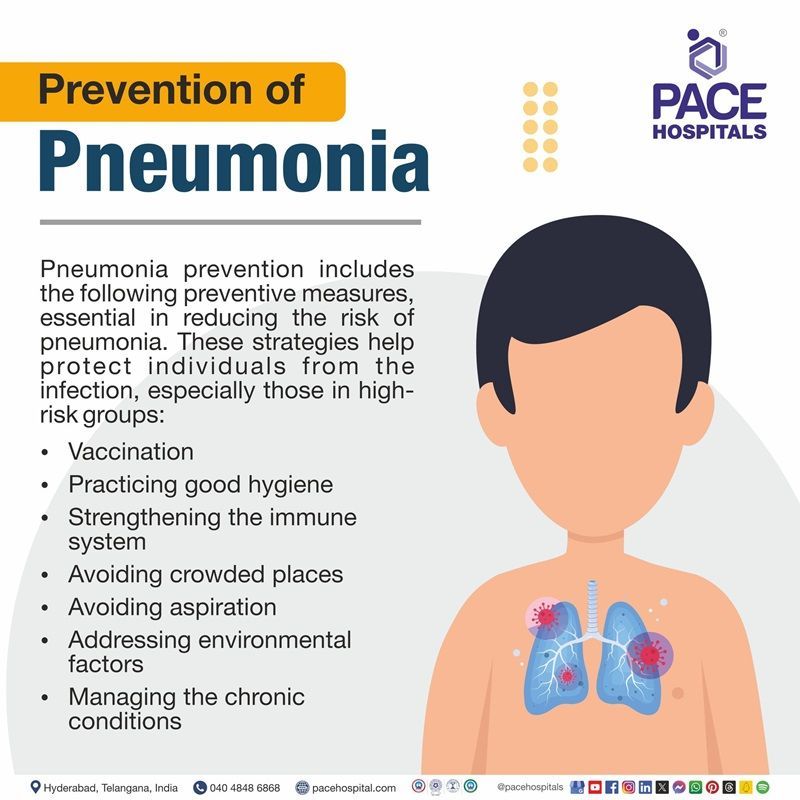
Pneumonia Prevention
Prevention and control of pneumonia include the following preventive measures, which are essential in reducing the risk of pneumonia. These strategies help protect individuals from the infection, especially those in high-risk groups:
- Vaccination: Vaccines, such as pneumococcal, RSV, COVID-19, and flu vaccines, can help prevent many common types of pneumonia caused by various causative agents, including bacteria and viruses. Immunisation against certain conditions, including Hib, measles, pneumococcus, and whooping cough (pertussis), is the most effective way to prevent pneumonia. Preventing it in children is an important component of a strategy to decrease child mortality.
- Practicing good hygiene: Regular handwashing and avoiding close contact with people affected by pneumonia can reduce the spread of germs (microorganisms) and prevent respiratory infections that may lead to pneumonia.
- Strengthen the immune system: Eating a balanced diet, exercising regularly, and getting enough sleep can strengthen the immune system and reduce susceptibility to infections.
- Avoiding crowded places: Crowding is an essential risk factor for various infectious diseases, making it easier to spread infections like pneumonia. Hence, encouraging young children and persons who are at high risk of pneumonia to avoid crowded places can help reduce the number of people who fall ill with pneumonia.
- Avoiding aspiration: For individuals at risk of aspiration, such as those with swallowing difficulties, it is important to be cautious about food and drink intake to prevent food or liquids from entering the lungs.
- Addressing environmental factors: Avoiding certain environmental factors, such as indoor air pollution and lung irritants like smoking (quitting smoking), can help reduce pneumonia risk.
- Treating the chronic conditions: Managing chronic diseases, especially in older patients, including diabetes, asthma, and heart conditions, can reduce the risk of pneumonia by preventing complications and improving overall health.
Difference Between Viral Pneumonia and Bacterial Pneumonia
Viral pneumonia vs bacterial pneumonia
Viral and bacterial pneumonias are both types of pneumonia. Although they may seem similar, they have following differences:
| Elements | Viral pneumonia | Bacterial pneumonia |
|---|---|---|
| Causes | Viral pneumonia causes include viruses such as influenza, RSV, coronaviruses, and others. | Bacterial pneumonia causes include bacteria like Streptococcus pneumoniae, Staphylococcus aureus, Mycoplasma pneumoniae, and others. |
| Symptoms | Common viral pneumonia symptoms include cough (usually dry or non-productive.), fatigue, fever (moderate to low-grade fever, not as high as in bacterial pneumonia), muscle aches, and sometimes shortness of breath. | Common bacterial pneumonia symptoms include, high fever, chills, cough (productive cough with yellow, green or bloody sputum), chest pain, and difficulty breathing. |
| Complications | Respiratory failure, secondary bacterial infections. | Sepsis, lung abscesses or pleural effusion |
| Duration | Symptoms may last 1-3 weeks, but recovery can take longer. | Often sudden and rapid onset. |
| Treatment | Antiviral medications and supportive care. | Antibiotics (e.g., penicillin, cephalosporins, macrolides, depending on the causative bacteria). |
Differences Between Pneumonitis and Pneumonia
Pneumonitis vs pneumonia
Pneumonitis and pneumonia both cause inflammation of the lungs; while infections primarily cause pneumonia, pneumonitis is often the result of non-infectious factors such as allergens, irritants, or environmental exposures. Below are the key differences between pneumonitis and pneumonia.
| Elements | Pneumonitis | Pneumonia |
|---|---|---|
| Causes | Inflammation of the lung tissue, typically due to an allergic reaction, irritants, or infections. | Inflammation of the lung, typically due to the Infection of the lung tissue, usually caused by bacteria, viruses, or fungi. |
| Symptoms | Common symptoms include cough, fatigue, shortness of breath, fever, and sometimes chest pain (usually milder than pneumonia). | Common pneumonia symptoms include, high fever, chills, cough (productive cough with yellow, green or bloody sputum), chest pain, and difficulty breathing. |
| Complications | Chronic lung damage, respiratory failure, fibrosis. | Sepsis, lung abscesses or pleural effusion |
| Risk factors | People with exposure to environmental toxins, certain medications, radiation therapy, or underlying lung conditions. | Contagious (spread through respiratory droplets or contact with infected surfaces). |
| Treatment | Treating the underlying cause (e.g., corticosteroids for inflammation, removal of irritants). | Antibiotics (for bacterial pneumonia), antivirals, antifungals (depending on causative organism). |
Frequently Asked Questions (FAQs) on Pneumonia
Is pneumonia dangerous?
Yes, pneumonia can be dangerous, especially for young children and those with weakened immune systems (e.g., older people) or underlying health conditions. Because this condition can lead to complications such as respiratory failure, sepsis, and organ damage. While many people recover with treatment, severe cases may require hospitalization or intensive care.
Can pneumonia be cured permanently?
Most pneumonia cases can be cured with appropriate treatment, especially if detected early and treated with the right medications. However, depending on the severity of the illness, some people may suffer from long-term effects, such as fatigue or lung damage. Addressing underlying conditions and risk factors for recurring pneumonia is essential to reducing the chances of future infections.
How to protect the child from pneumonia?
Vaccination is the foremost preventive step, so ensuring the child receives all recommended vaccinations, such as the flu and pneumococcal vaccines, can help protect the child from pneumonia. Promoting good hygiene, including regular handwashing, avoiding environmental pollutants, ensuring healthy food, and covering coughs, can also help the child avoid pneumonia.
What is the greatest risk for pneumonia?
Individuals at highest risk for bacterial pneumonia include those recovering from surgery, those with respiratory diseases or viral infections, and those with weakened immune systems.
Is pneumonia dangerous during pregnancy?
Pneumonia can be risky during pregnancy, leading to complications like premature labour, low birth weight, and respiratory distress. Early identification and treatment with modern antibiotics have significantly decreased the risks for mothers. Additionally, vaccination for at-risk groups may help lower the severity and prevalence of pneumonia in pregnant women.
Is pneumonia contagious?
Pneumonia can be contagious, depending on the cause. Usually, viral and bacterial pneumonia can be spread through respiratory droplets when an infected person talks, coughs, or sneezes from person to person. The transmission risk is higher in crowded environments, such as schools or hospitals. However, some types of pneumonia, such as fungal pneumonia, are not contagious.
How can someone recognize the signs of pneumonia?
If anyone experiences symptoms such as cough (persistent), fever, chest pain, chills and difficulty breathing, these symptoms could indicate lung infection, including pneumonia. However, if these conditions worsen, it is necessary to visit a healthcare professional for medical evaluation and management.
What is walking pneumonia?
Walking pneumonia, also called Atypical pneumonia, is named due to its milder symptoms and slower onset. It is often characterised by an acute lung infection caused by pathogens not detectable by traditional Gram stain or standard bacterial cultures. Common atypical pneumonia causes include Mycoplasma pneumoniae, Legionella pneumophila and Chlamydophila pneumoniae. These infections often present with less severe respiratory symptoms and more systemic manifestations than typical bacterial pneumonia.
How to cure pneumonia?
Pneumonia treatment depends on the underlying cause. For instance, viral pneumonia can be treated with antiviral medications or supportive care, including rest and fluids, whereas bacterial pneumonia is usually treated with antibiotics. In severe cases, hospitalization may be necessary for oxygen therapy or IV medications. However, following the prescribed treatment and adequate rest is crucial for faster recovery.
What is the recommended diet for pneumonia recovery?
A nutritious diet that boosts the immune system is important when dealing with pneumonia. Foods rich in vitamins A, C, and E, like fruits and vegetables, can help fight infections. Protein-rich foods such as fish, legumes, and lean meats help in tissue repair. Staying hydrated is also essential for mucus clearance.
What is the difference between pneumonia and covid 19?
While both affect the lungs, COVID-19 is a viral infection caused by SARS-CoV-2 virus, with unique long-term effects, whereas pneumonia can be caused by a range of infectious agents (bacteria, viruses, and fungi). Pneumonia symptoms include cough, fever, and difficulty breathing. COVID-19 can also lead to pneumonia but is specifically associated with symptoms such as loss of taste or smell and a higher risk of severe respiratory distress.
What else one can do to keep lungs healthy?
Practising good health habits, such as maintaining oral hygiene, washing hands, avoiding crowds, quitting smoking, eating a healthy diet, getting enough rest, exercising regularly and avoiding exposure to lung irritants, can help prevent pneumonia and other lung conditions.
What is the difference between pneumonia and tuberculosis?
Pneumonia and tuberculosis (TB) are both common lung infections, but they differ in their causes and characteristics. Pneumonia is usually caused by various infections, including bacteria, viruses, or fungi, leading to inflammation of the air sacs in the lungs, often with symptoms such as cough, fever, and difficulty breathing. On the other hand, tuberculosis is caused by a chronic bacterial infection called Mycobacterium tuberculosis, primarily affecting the respiratory organs (lungs) but can spread to other organs. TB develops more slowly and can be latent, while pneumonia usually presents acutely. Treatment for pneumonia often involves antibiotics, whereas TB requires long-term, multi-drug therapy.
Share on
Request an appointment
Fill in the appointment form or call us instantly to book a confirmed appointment with our super specialist at 04048486868

